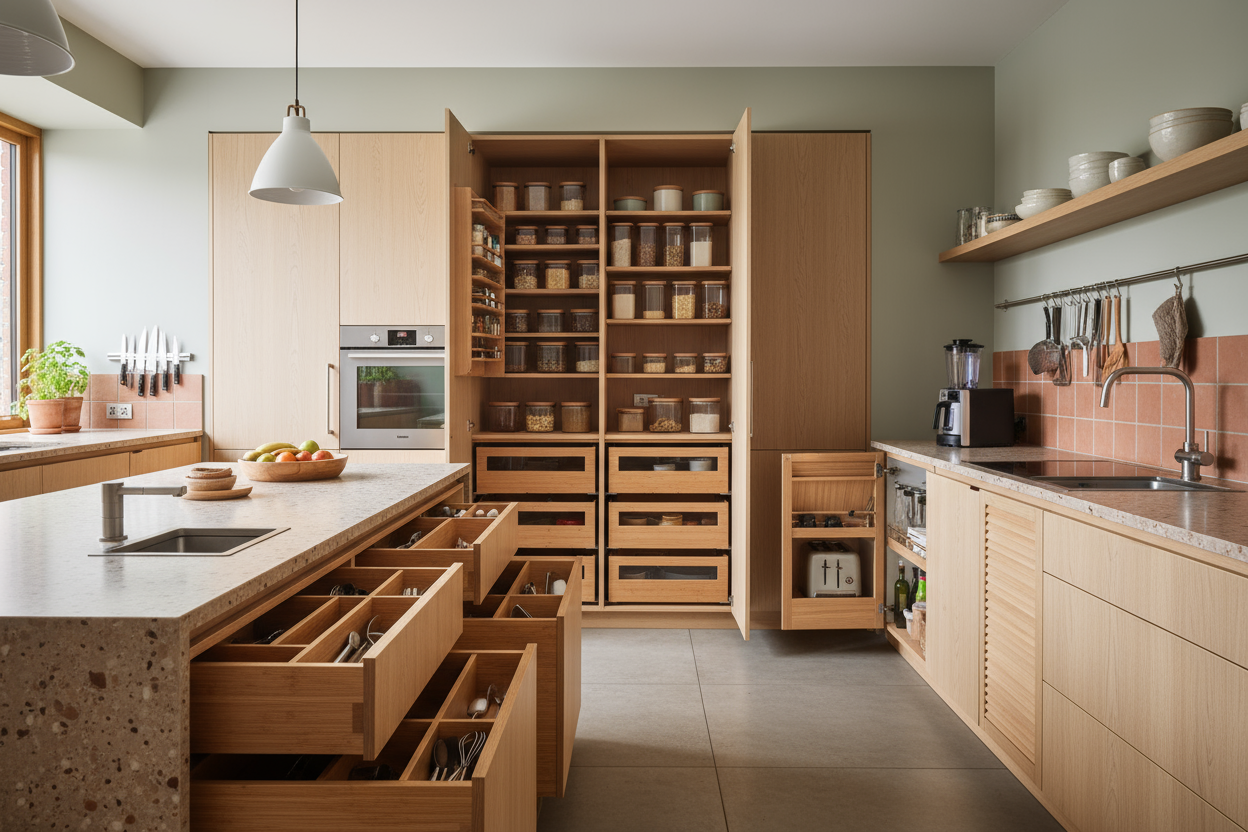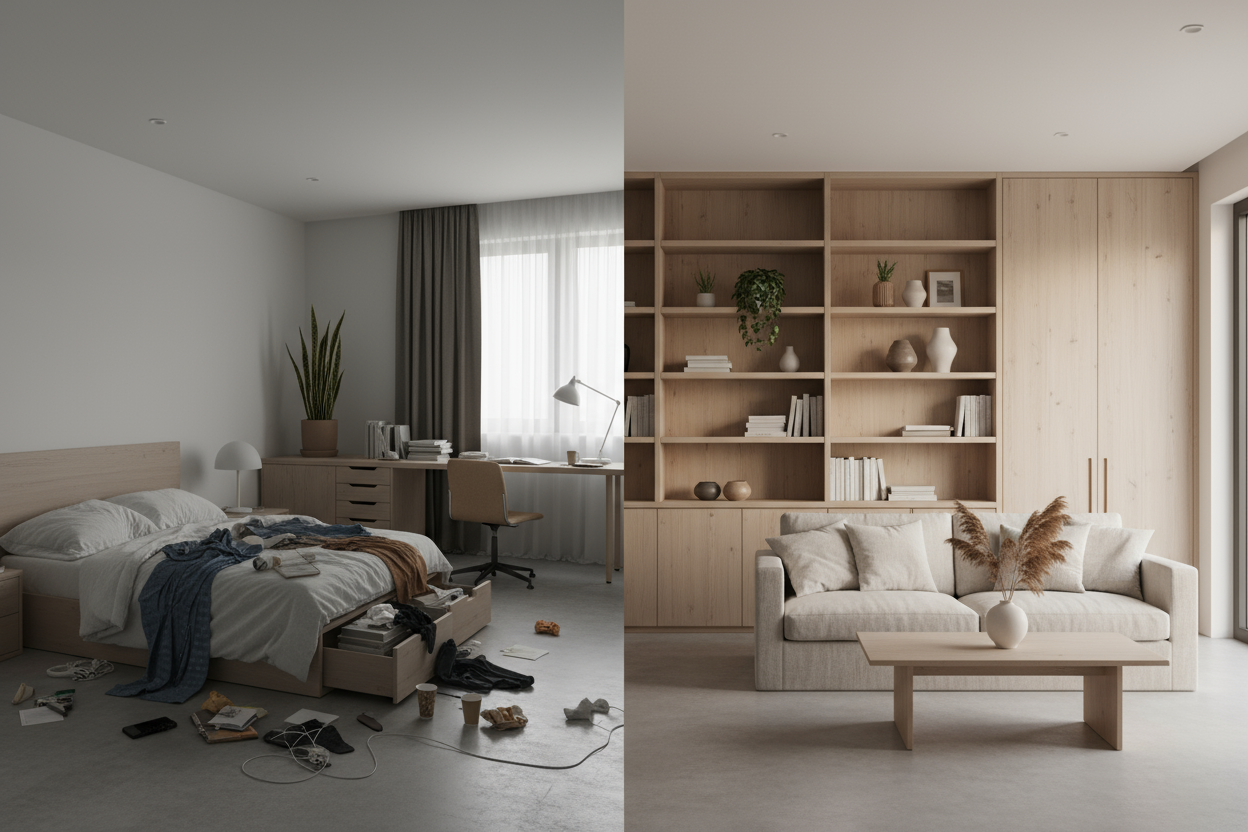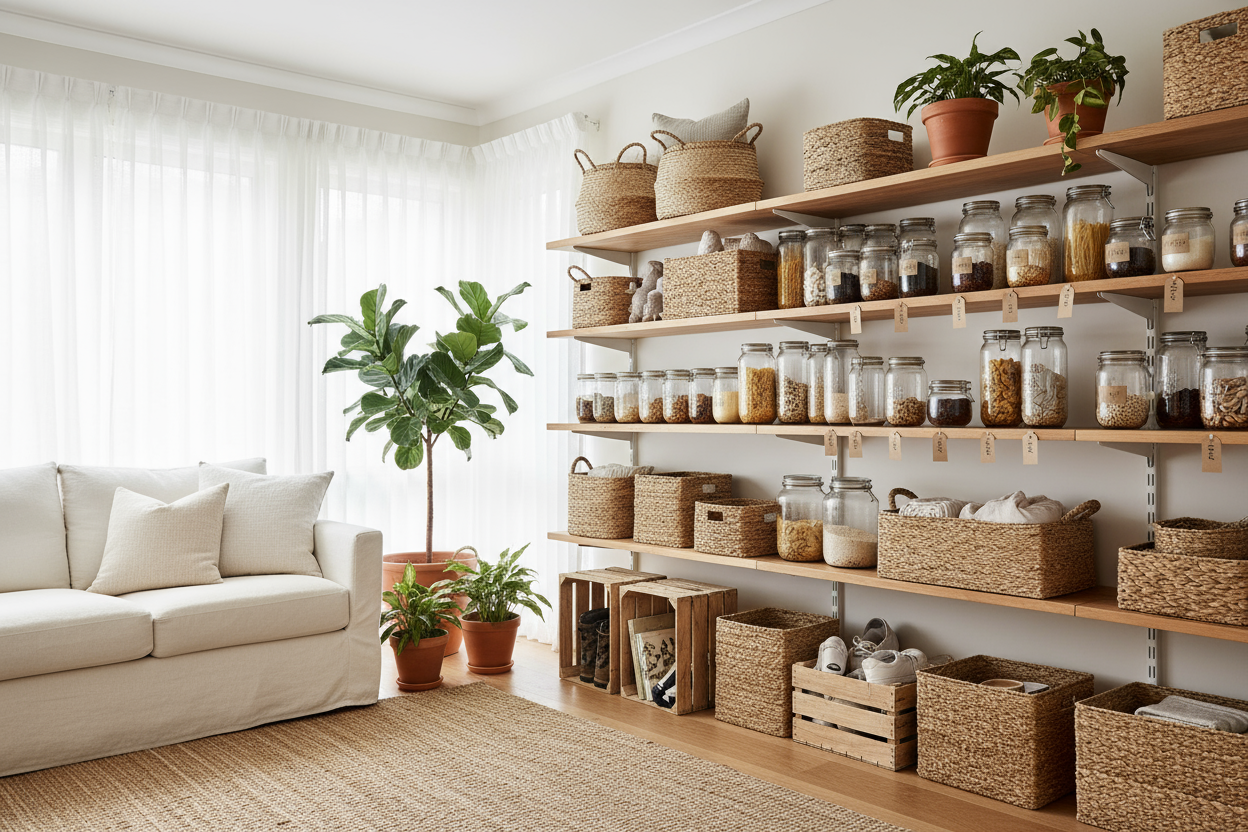Australian kitchens are evolving beyond the Instagram-worthy aesthetics that dominated the past decade. As we move into 2025, homeowners are prioritising functionality, stress reduction, and personalised storage solutions over fleeting design trends. This shift reflects a growing understanding that the kitchen is the heart of the home, requiring thoughtful organisation that supports daily life rather than just looking picture-perfect.
The kitchen organisation trends gaining traction this year focus on creating systems that actually work for busy Australian families. From hidden storage solutions that maintain clean sightlines to modular pantry systems that adapt to changing needs, these approaches emphasise practicality without sacrificing style.
The Return of Functional Storage Over Open Display
One of the most significant shifts in kitchen organisation for 2025 is the move away from open shelving towards more practical closed storage. While open shelves dominated social media feeds in recent years, many homeowners have discovered the reality of maintaining exposed dishware and ingredients. Dust accumulation, visual clutter, and the pressure to keep everything perfectly arranged have led to a preference for closed cabinetry that conceals the everyday chaos of cooking.
This trend aligns with a broader desire for kitchens that function efficiently without constant maintenance. Closed storage allows you to quickly tidy away items between cooking sessions, creating a cleaner appearance with minimal effort. Professional chefs have long advocated for storage systems that prioritise accessibility over display (insert culinary professional citation), and this wisdom is finally reaching domestic kitchens.
The key is finding storage solutions that balance hidden functionality with easy access. Look for cabinets with interior organisation systems, pullout drawers that maximise depth, and vertical dividers that keep items visible and reachable within closed spaces.
[collection-carousel="kitchen-storage-solutions"]
Zone-Based Kitchen Organisation
Creating distinct zones within your kitchen layout is becoming essential for efficient meal preparation and cleanup. This approach assigns specific areas for different activities, reducing the time spent searching for tools and ingredients. The most effective kitchen zones typically include a prep area near the sink, a cooking zone around the stovetop, a storage zone for dry goods, and a cleanup station near the dishwasher.
Within each zone, storage should reflect the specific tasks performed there. The prep zone benefits from knife storage, cutting board organisation, and easy access to frequently used ingredients. The cooking zone requires pot and pan storage, spice organisation, and tool accessibility. This systematic approach reduces movement during cooking and creates more intuitive storage habits.
Consider how you naturally move through your kitchen during meal preparation. Do you find yourself constantly walking back and forth for items? Zone-based organisation can significantly reduce these inefficient movements by placing related items in logical proximity to where they're used.
Appliance Garages and Hidden Stations
The appliance garage concept is experiencing a major revival in 2025, offering a solution to counter clutter while maintaining appliance accessibility. These dedicated spaces, often built into cabinetry with rollup doors or sliding panels, allow you to store frequently used appliances like coffee machines, blenders, and toasters without sacrificing counter space.
Beyond simple concealment, modern appliance garages incorporate power outlets and ventilation, creating functional stations that can operate while partially enclosed. This approach is particularly valuable for coffee stations, which benefit from dedicated water lines and electrical connections while remaining hidden when not in use.
The trend extends to creating specialised stations for specific activities. Baking stations might include ingredient storage, measuring tools, and mixer placement. Smoothie stations could incorporate blender storage with easy access to protein powders and supplement containers.
Maximising Vertical and Hidden Storage
Australian homes, particularly in urban areas, often feature compact kitchens where every centimetre counts. The 2025 approach to kitchen organisation emphasises vertical storage solutions and utilising previously unused spaces. This includes the inside of cabinet doors, the space above cabinets, and narrow gaps between appliances.
Door-mounted racks can transform the inside of cabinet doors into valuable storage for spices, cleaning supplies, or frequently used condiments. These solutions keep items visible and accessible while freeing up shelf space for larger items. Similarly, narrow pullout drawers can utilise spaces that were previously unusable, such as the gap beside a refrigerator or between cabinets.
Under-sink areas, often underutilised due to plumbing obstacles, benefit from organisation systems designed around existing pipes. Tiered shelving, pullout drawers on slides, and door-mounted storage can transform these awkward spaces into functional storage zones.
[collection-carousel="kitchen-storage-shelves-racks"]
Pantry Evolution and Modular Systems
The traditional pantry is evolving into a more sophisticated storage system that adapts to changing household needs. Modular pantry organisation allows you to reconfigure storage as your cooking habits, family size, and food preferences change over time. This flexibility proves particularly valuable for Australian families dealing with seasonal produce variations and bulk buying trends.
Successful pantry organisation in 2025 focuses on visibility and accessibility. Clear containers with airtight seals protect ingredients while allowing you to quickly assess quantities. Adjustable shelving accommodates items of varying heights, while pullout drawers bring back-of-shelf items within easy reach.
The key to effective pantry storage lies in grouping similar items together and maintaining consistent container sizes where possible. This approach creates visual cohesion while simplifying restocking and meal planning processes.
Sustainable and Multipurpose Solutions
Environmental consciousness is driving kitchen organisation choices in 2025, with many Australians seeking storage solutions that reduce waste and support sustainable practices. This includes investing in quality containers that eliminate single-use packaging, storage systems that extend food freshness, and multipurpose tools that reduce overall kitchen clutter.
Bulk storage containers that accommodate larger quantities of staples like rice, flour, and pasta support both environmental goals and cost savings. These containers often feature airtight seals that preserve freshness longer than original packaging, reducing food waste while maintaining ingredient quality.
Multipurpose storage solutions are gaining popularity as kitchens serve multiple functions within modern Australian homes. Storage islands that provide prep space, dining surfaces, and hidden storage exemplify this trend. Similarly, wall-mounted systems that can hold everything from utensils to recipe tablets offer flexibility in smaller spaces.
Personalisation Over Trend Following
Perhaps the most significant shift in kitchen organisation for 2025 is the movement away from prescriptive design trends towards personalised solutions. Many Australian homeowners are rejecting the pressure to follow popular styles that don't suit their actual cooking habits, family size, or lifestyle requirements.
This personalised approach considers how you actually use your kitchen rather than how it might photograph. If you rarely bake, dedicating prime storage to baking equipment makes little sense. If you cook large family meals regularly, your organisation needs differ significantly from someone who primarily reheats prepared foods.
The trend towards personalisation also recognises that effective organisation systems must align with your natural habits. If you tend to leave items on counters, incorporating designated landing zones with attractive containers can work better than fighting against this tendency.
Technology Integration
Smart technology is increasingly integrated into kitchen organisation systems, though the focus remains on practical functionality rather than novelty. Inventory tracking systems, such as smart pantry sensors or barcode scanning apps (insert citation), help manage pantry contents more efficiently, while app-controlled lighting improves visibility in deep cabinets and storage areas.
The most successful technology integration supports existing organisation systems rather than replacing them. Smart labels that update inventory levels, automated reordering for frequently used items, and voice-activated timers that coordinate with storage zones all enhance the organisation process without adding complexity.
Creating Your 2025 Kitchen Organisation Plan
These recommendations are informed by practical insights from years of working with Australian households on kitchen planning and optimisation.
Implementing these trends requires a systematic approach that considers your specific needs, space constraints, and budget. Start by auditing your current kitchen use patterns. Track which items you reach for most frequently, identify areas where clutter accumulates, and note any storage pain points that slow down your cooking process.
Prioritise changes based on impact and feasibility. Simple improvements like drawer organisers or pantry containers can provide immediate benefits while you plan larger modifications. Focus on solutions that address your most frequent frustrations first, as these changes will have the greatest daily impact.
Consider the longevity of any organisation system you implement. Quality storage solutions that can adapt to changing needs provide better value than trend-focused options that may become outdated quickly. Look for modular systems that can grow with your requirements and multipurpose solutions that serve multiple functions.
Remember that effective kitchen organisation is an ongoing process rather than a one-time project. Regular review and adjustment ensure your systems continue meeting your needs as cooking habits and household requirements evolve.
For comprehensive storage solutions that align with 2025 organisation trends, explore our complete range of kitchen storage options designed for Australian homes. Whether you're seeking modular pantry systems, space-saving drawer organisers, or multipurpose storage solutions, you'll find practical options that support efficient, personalised kitchen organisation.
Conclusion
The kitchen organisation trends shaping 2025 reflect a mature understanding of how Australians actually live and cook. By prioritising functionality over aesthetics, personalisation over popular trends, and sustainable solutions over quick fixes, these approaches create kitchens that genuinely support daily life.
The shift away from open shelving towards functional closed storage, the emphasis on zone-based organisation, and the integration of technology that enhances rather than complicates these systems all point towards a more thoughtful approach to kitchen design. As you consider updating your own kitchen organisation, focus on solutions that align with your actual cooking patterns and lifestyle requirements rather than following prescriptive trends that may not suit your needs.
Successful kitchen organisation in 2025 is about creating systems that reduce stress, support your cooking goals, and adapt to changing requirements over time. By implementing these evidence-based approaches thoughtfully, you can create a kitchen that truly serves as the functional heart of your Australian home.





